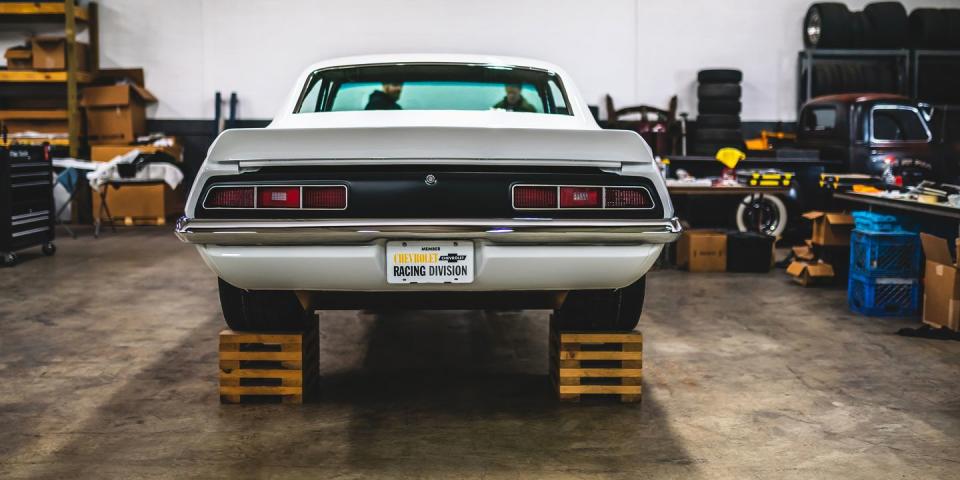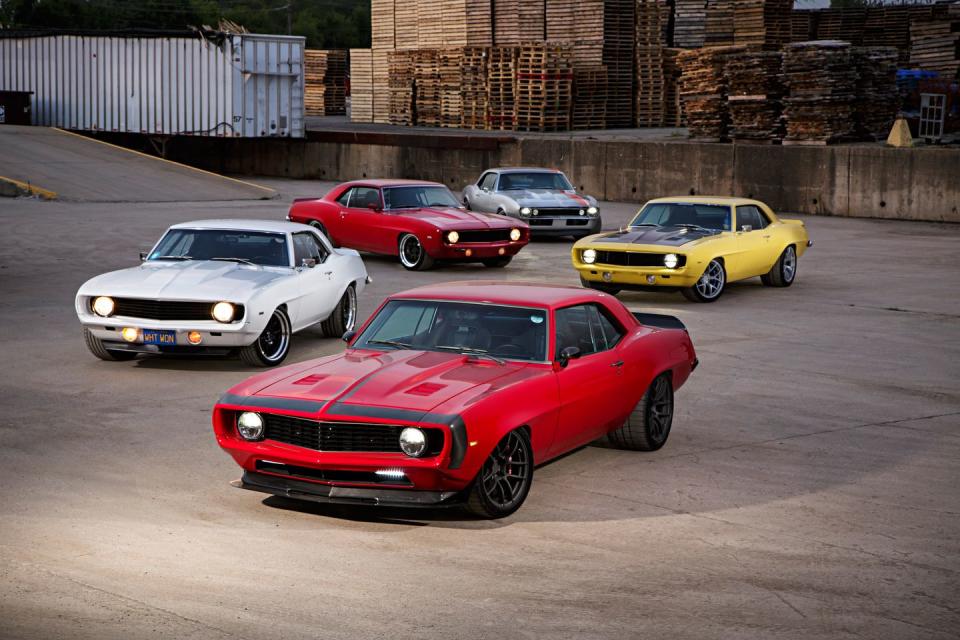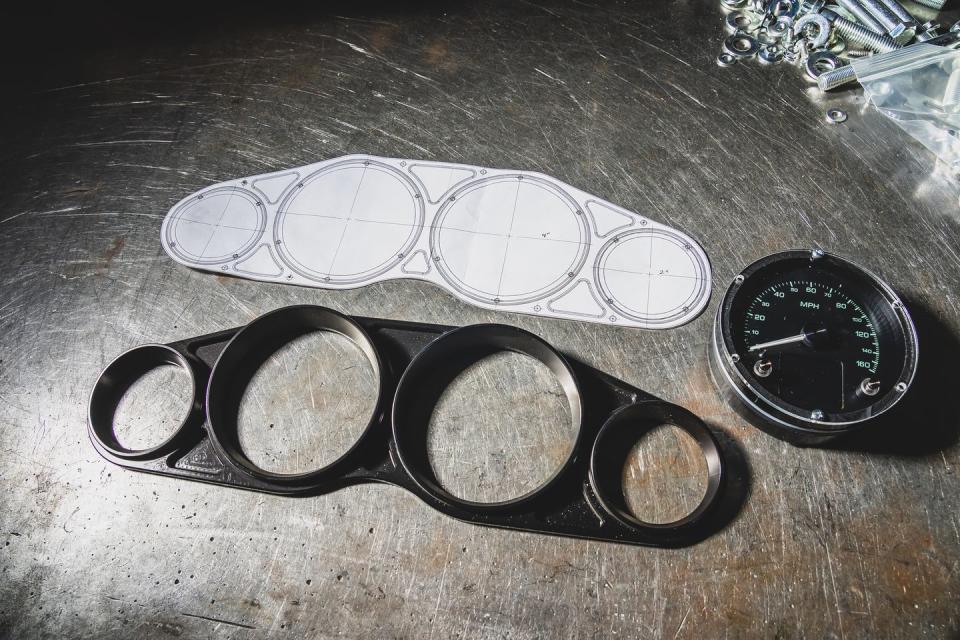The Man Who Invented Pro Touring Is Still Perfecting the First-Gen Camaro

Muscle-car loyalty runs bone deep. Throughout the industrial Midwest, it’s forged early, in families whose livelihoods depend on a healthy domestic car industry. Before the squalling infant knows it, his umbilical cord is in a neat Chevy bowtie. Or Pops may hover over the crib, repeating, “Say Mopar. MO-paar.” The factory die has been cast. Matchboxes and Revell models follow. Dinner-table discussions leave little room for dissent: Brand X will win the race and rescue the planet. Brand Y is shit, best left to perverts or junkies. Now take out the garbage, and grab me a beer.
Mark Stielow knows this. The Missouri product and engineer—now director of GM Motorsports Competition Engineering—built his reputation by creating some of the world’s fastest, most fantastical muscle cars. But there’s a skeleton in his Chevy-wardrobed closet: The GM lifer, the Obi-Wan of the fabled ’69 Camaro and the Pro Touring movement, was once a Ford man.
This story originally appeared in Volume 3 of Road & Track.
SIGN UP FOR THE TRACK CLUB BY R&T FOR MORE EXCLUSIVE STORIES
Stielow confesses this in a shop called Sled Alley Hot Rods located in Detroit’s east-side suburbs. That’s where his latest, decidedly bitchin’ Camaro has been taking shape over two years.
“I grew up in a Ford family, and that’s all I had until I went to GM: ’69 and ’70 Mustang Boss 302s, ’71 Mach 1, just a ton of ’em,” Stielow says. That included the ’66 Mustang fastback he drove to his first day as a GM intern 33 years ago.
Here at Sled Alley, just a few stoplight races from the Tech Center where Stielow started his GM career, the man resembles a technical drawing of a Detroit engineer. He’s got a problem-solver’s manner, frameless specs, and brown hair just a few millimeters beyond buzzcut. The self-described “punk kid from Missouri” says he dreamed of working for Ford and didn’t particularly like Camaros. But only Caterpillar and GM offered jobs to the University of Missouri-Rolla student.
“I decided I needed to get a Chevrolet,” he says, and he let a buyer drive off with his Mustang and a garage full of Ford parts. But Corvettes were too expensive, Chevelles too big. “Just-right” was a white, rust-free ’69 Camaro RS with 50,000 miles, for which Stielow paid $3800. Cue the lightning bolt, with small-block Chevy thunder.
“Suddenly I got it: This is why everyone hopped-up old, crappy Camaros,” he said. “Everything just worked better than the Fords: easier to work on, the engines made big power easier.”
The rest is muscle-car history that’s still unfolding, from Chevy showrooms to grassroots shops like Sled Alley, where owner and fabricator extraordinaire Matt Gurjack is one of Stielow’s many friends and colleagues in Pro Touring. Another is Detroit Speed—in Mooresville, North Carolina—where Kyle Tucker, Stielow’s former college classmate and fellow GM engineer, builds slick components to time-warp vintage Camaros, Firebirds and other models into 1-g-cornering marvels.
So what’s a Pro Touring car? In the tangled genealogy of hot rods, with more subgenres than EDM, a Pro Touring car is a restomod’s high-net-worth cousin. Both masquerade as vintage beauties, tucking modern parts below half-century-old skins. But a PT car has enough mechanical massaging—engine, chassis, suspension, brakes, tires—to hang with or humble late-model sports and muscle cars. Stielow himself coined the term Pro Touring in 1999 and it stuck.

Like many youngsters before him, Stielow learned the Camaro’s limitations the hard way, wrecking two while balancing college with supporting GM’s showroom-stock racing. Between GM blueprints of the prized “tri-year” Camaros, built from 1967 to 1969—from the Summer of Love to Altamont—and his own engineering skills, he cobbled together the first PT car in his Royal Oak, Michigan, garage. This triple-threat (track, strip, and street) was later dubbed “Tri-Tip.” He and Tucker drove that ’69 Camaro in the 1993 One Lap of America, the Car and Driver event that combined road courses, autocross, drag runs, and sleep-deprived interstate miles, the latter spawning the pragmatic overdrive gears found on all 17 first-gen Camaros he’s built. This first Frankenstein monster—or Mr. Potato Head, as Stielow dubs his cars’ assortment of parts—coaxed 475 horses from Chevy’s biggest small-block, a 400-cubic-incher with fuel injection.
“You have to remember, in 1993 even a Corvette had 300 horsepower and was pretty anemic,” Stielow says. “You show up with a 475-hp Camaro, with full performance mods, and it was pretty revolutionary.”
That first One Lap ended with an uncooperative fuel line and engine-bay fire at Michigan International Speedway. Undaunted, Stielow returned to score One Lap class wins in 1994 and 1995. The Frigidaire-white Chevy took a remarkable fourth overall in ’95, behind ringers like pro racer David Murray in the winning Porsche 911 Turbo.
The word was out. Stielow’s dream machines began hogging the covers of hot-rod mags like Cindy Crawford on Vogue. Power and capability kept growing, lap times shrinking. His ’69 Camaro, Red Devil, had a 760-hp supercharged 7.0-liter V-8 that was a mashup of LS7 and LS9 parts, plus Corvette-based ABS, a first in a Stielow car. Red Devil cemented his legacy, winning the Optima Ultimate Street Car Invitational in 2010 and becoming immortalized in Gran Turismo 6.
“You can crash my car, hit ‘reset’ and not have to rebuild it,” Stielow says.
Disciples began building their own PT cars, inspired to climb toward Stielow’s Olympian standards. His trailblazing advice is collected in the how-to book Pro Touring Engineered Performance. That blue-ribbon goal is not for the backyard mechanic on a Pabst budget. Farm it out, and Gurjack figures a good 1500 hours of labor. At $60 an hour, that’s $90,000, before the first race-built engine or catalog wish list is tallied. Compatible donor cars are scarce and expensive, despite Chevy having built 243,085 Camaros in ’69 alone. These were throwaway cars, often disposed of by rust, abuse, or the first telephone pole a teenager could wrap one around. Stielow does a quick phone search of ’69s for sale, which range from $26,000—“for a pretty roach-y car,” he cautions—to $132,000 for a primo Z/28.

One completed specimen rests here at Sled Alley: a ’67 Camaro built by Stielow’s friend Gordon Rojewski, its patinated, Marina blue surface disguising a 680-hp Chevy LS7.
But the star is Stielow’s latest ingenue, set to debut at the COVID-delayed Barrett-Jackson extravaganza in Scottsdale, Arizona. It’s called Apex, a fitting name for a curve predator that should corner at about 1.15 g’s. The museum-level ’69 body is white, again, a color that barely enters the flame-licked hellscapes of most hot-rod fans. Stielow just likes white cars.
Apex is propelled by an upgraded version of the Corvette ZR1’s already absurdly powerful supercharged LT5 V-8. An unmodified crate version will set you back about $19,000. Obviously, the standard 755 horses were not enough.

 Yahoo Autos
Yahoo Autos 